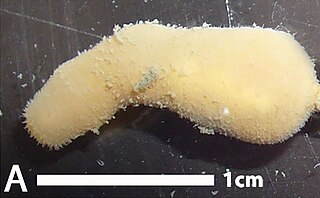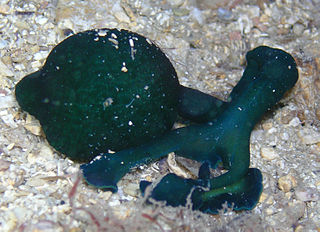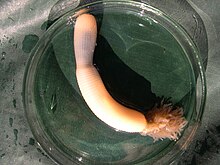
The Sipuncula or Sipunculida is a class containing about 162 species of unsegmented marine annelid worms. The name Sipuncula is from the genus name Sipunculus, and comes from the Latin siphunculus meaning a "small tube".

The Echiura, or spoon worms, are a small group of marine animals. Once treated as a separate phylum, they are now considered to belong to Annelida. Annelids typically have their bodies divided into segments, but echiurans have secondarily lost their segmentation. The majority of echiurans live in burrows in soft sediment in shallow water, but some live in rock crevices or under boulders, and there are also deep sea forms. More than 230 species have been described. Spoon worms are cylindrical, soft-bodied animals usually possessing a non-retractable proboscis which can be rolled into a scoop-shape to feed. In some species the proboscis is ribbon-like, longer than the trunk and may have a forked tip. Spoon worms vary in size from less than a centimetre in length to more than a metre.

Priapulida, sometimes referred to as penis worms, is a phylum of unsegmented marine worms. The name of the phylum relates to the Greek god of fertility, because their general shape and their extensible spiny introvert (eversible) proboscis may resemble the shape of a human penis. They live in the mud and in comparatively shallow waters up to 90 metres (300 ft) deep. Some species show a remarkable tolerance for hydrogen sulfide, anoxia and low salinity. Halicryptus spinulosus appears to prefer brackish shallow waters. They can be quite abundant in some areas. In an Alaskan bay as many as 85 adult individuals of Priapulus caudatus per square meter has been recorded, while the density of its larvae can be as high as 58,000 per square meter.

Ottoia is a stem-group archaeopriapulid worm known from Cambrian fossils. Although priapulid-like worms from various Cambrian deposits are often referred to Ottoia on spurious grounds, the only clear Ottoia macrofossils come from the Burgess Shale of British Columbia, which was deposited 508 million years ago. Microfossils extend the record of Ottoia throughout the Western Canada Sedimentary Basin, from the mid- to late- Cambrian. A few fossil finds are also known from China.

Scalidophora is a group of marine pseudocoelomate protostomes that was proposed on morphological grounds to unite three phyla: the Kinorhyncha, the Priapulida and the Loricifera. The three phyla have four characters in common — chitinous cuticle that is moulted, rings of scalids on the introvert, flosculi, and two rings of introvert retracts. However, the monophyly of the Scalidophora was not supported by two molecular studies, where the position of the Loricifera was uncertain or as sister to the Panarthropoda. Both studies supported a reduced Scalidophora comprising the Kinorhyncha and Priapulida as sister phyla. Their closest relatives are the Panarthropoda, Nematoda and Nematomorpha; thus, they are placed in the group Ecdysozoa.
Fieldia is a genus of worms known from the Cambrian Burgess Shale, and assigned to the priapulids.

Worms are many different distantly related bilateral animals that typically have a long cylindrical tube-like body, no limbs, and no eyes.
Golfingia vulgaris is a marine invertebrate belonging to the phylum Sipuncula, the peanut worms. It is a cylindrical, unsegmented worm with a crown of tentacles around the mouth. It lives in burrows in shallow seas in various parts of the world.

Sipunculus nudus is a cosmopolitan species of unsegmented marine worm of the phylum Sipuncula, also known as peanut worms.

Halicryptus is the sole genus of its class of priapulid worms, and grows to great size. It has an important effect on the structure of soft-sediment communities.
Phascolopsis gouldii is a species of unsegmented benthic marine worm, also known as a peanut worm or star worm. It lives in burrows in muddy sand in shallow waters off North America.
Nephasoma minutum is a marine invertebrate of the phylum Sipuncula, commonly known as peanut worms because of their shape when contracted. It is a cylindrical, unsegmented worm with a crown of tentacles around the mouth. These worms live in crevices in the rocks or in burrows in shallow water in Western Europe, and the eastern United States.

Bonelliidae is a family of marine worms noted for being sexually dimorphic, with males being tiny in comparison with the females. They occupy burrows in the seabed in many parts of the world's oceans, often at great depths.

Urechis caupo is a species of spoon worm in the family Urechidae, commonly known as the innkeeper echiuran, the fat innkeeper worm, the innkeeper worm, or the penis fish. It is found in shallow water on the west coast of North America, between southern Oregon and Baja California, where it forms a U-shaped burrow in the sediment and feeds on plankton using a mucus net.

Aspidosiphon muelleri is a species of unsegmented benthic marine worm in the phylum Sipuncula, the peanut worms. This worm is found in the eastern Atlantic Ocean, the Mediterranean Sea and in various locations in the Indo-Pacific region at depths down to about 1,000 m (3,300 ft).

Echiurus echiurus is a species of spoon worm in the family Echiuridae. It is found in the North Atlantic Ocean and a subspecies is found in Alaska. It burrows into soft sediment and under boulders and stones in muddy places.
Themiste hennahi is a species of unsegmented benthic marine worm in the phylum Sipuncula, the peanut worms. It is native to shallow waters on the Pacific coast of North and South America. This worm was first described in 1828 by the British zoologist John Edward Gray as Themiste hennahi, the type specimen having been collected by the Rev. W. Hennah, with the type locality being Peru.
Maxmuelleria lankesteri is a species of spoon worm in the family Bonelliidae. It is found in the North Atlantic Ocean. It burrows into soft sediment on the seabed, mostly in deep water.

Themiste pyroides is a species of unsegmented benthic marine worm in the phylum Sipuncula, the peanut worms. It occurs in the intertidal zone and shallow water in the western Atlantic Ocean and the northeastern Pacific Ocean. It lives in crevices and under rocks, extending its "crown" of branching tentacles into the surrounding water to feed.
Thysanocardia procera is a marine invertebrate belonging to the phylum Sipuncula, the peanut worms. It is a cylindrical, unsegmented worm with a crown of tentacles around the mouth. It is native to shallow seas in the northeastern Atlantic Ocean.













